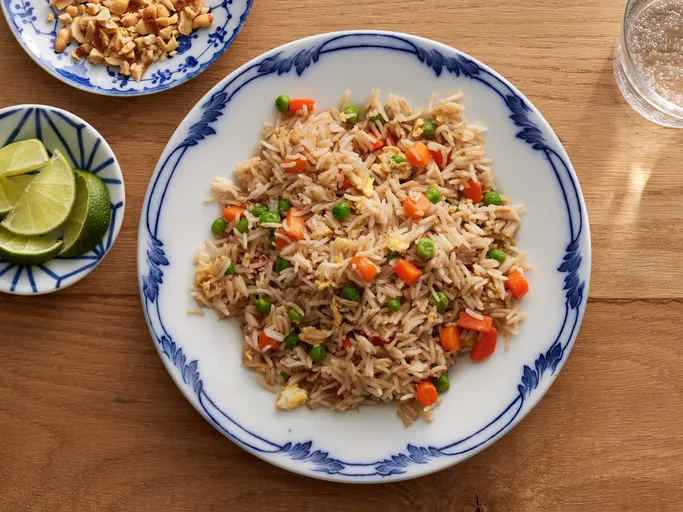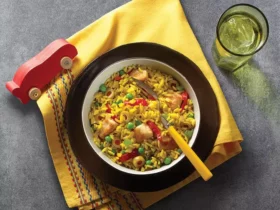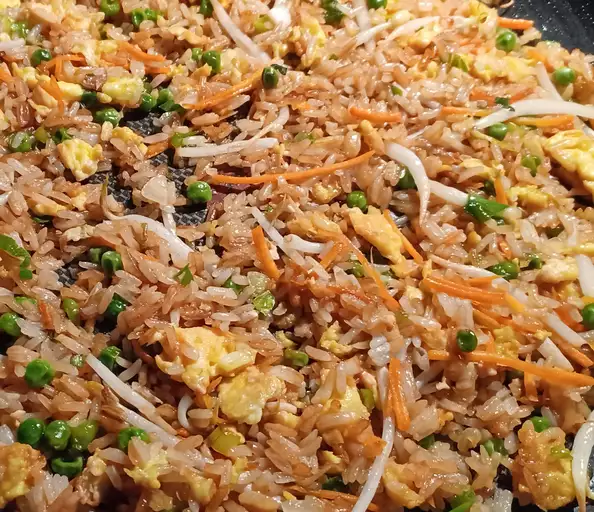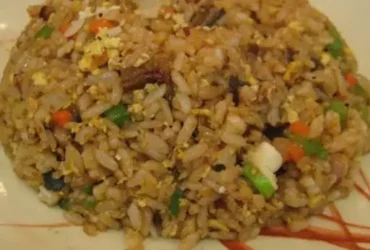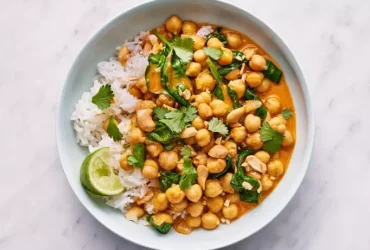Ingredients and Preparation
Gather Essential Ingredients
To make this easy fried rice recipe, you will need the following essential ingredients:
- Rice: Cooked and cooled Chinese-style long-grain rice (preferably day-old rice)
- Protein: Diced cooked chicken, beef, pork, or shrimp (or a combination of your choice)
Vegetables:
- Diced carrots
- Diced green onions
- Sliced mushrooms
- Cut scallions (green and white parts)
- Sliced bean sprouts
Flavorings:
- 2 tablespoons vegetable oil or peanut oil
- 1 small onion, diced
- 2 cloves garlic, minced
- 1 teaspoon grated fresh ginger
- Soy sauce (or tamari for gluten-free option)
Seasonings:
- Salt and pepper to taste
- Freshly ground black pepper, if desired
Others:
- 2 green onions, chopped (for garnish)
- Sesame oil or seeds (optional)
Please note that you can customize the ingredients and their quantities based on your preferences and dietary requirements.
Before starting with the recipe, ensure that all your ingredients are ready to go. You’ll also want to have a wok or large skillet over medium-high heat for stir-frying.
Rice: Use dayold cooked rice or leftover rice to prevent clumping.
To prepare fried rice that turns out fluffy, separate, and full of flavor, you need to start with day-old cooked rice or leftover rice. This type of rice has a drier consistency compared to freshly cooked rice, which prevents it from clumping together.
Here are the reasons why you should use day-old cooked rice:
- Prevents Rice Clumping: Using fresh rice can lead to clumps forming as you stir-fry, resulting in an unpleasant texture. Day-old or leftover rice avoids this issue and ensures a smooth consistency throughout your fried rice dish.
- Simplifies Cooking Process: Preparing day-old cooked rice for frying is quick and easy. Simply break up the lumps with a spoon or fork to create individual grains of rice, ready for sautéing.
- Enhances Texture and Flavor: The drier consistency of leftover rice helps it brown better when cooked, giving your fried rice an appetizing golden hue. This browning process enhances the overall flavor of your dish and contributes to its characteristic crunchy texture.
Protein source (e.g., eggs, cooked chicken, or tofu): Chop into bitesized pieces.
- The protein source for this recipe can be any desired food item, such as cooked chicken or tofu. However, let’s use cooked chicken as an example.
- To prepare the chicken, reheat it in a pan over low heat until it is warmed through. Then, chop it into bite-sized pieces and set it aside for later use.
- Next, choose a protein source other than cooked chicken. This can be eggs or tofu. For this example, let’s assume we are using tofu.
- Cut the tofu into bite-sized pieces as well. If using eggs, chop them into small pieces and set both aside for later use in the recipe.
- It is essential to note that the protein source can vary based on personal preference or dietary requirements. Feel free to experiment with different options to find your favorite combination.
Veggies (e.g., carrots, peas, onions): Dice into small pieces.
The ingredients and preparation for a delicious and easy fried rice recipe involve several key components. Here’s a breakdown of the veggies and how to prepare them:
Veggies
- Carrots: Peel and dice into small pieces
- Peas: No need to chop, but you can rinse them under cold water to remove any debris
- Onions: Dice into small pieces, but make sure they’re not too fine as they’ll cook quickly and become overcooked
Preparation of Veggies
The prep work for the veggies is quite straightforward. You can use a knife or a food processor to chop them into smaller pieces. Make sure the carrots are peeled first, as the skin can be tough and fibrous.
For the peas, you don’t need to chop them at all, but rinsing them under cold water will help remove any debris that might have accumulated on the surface. The same applies to the onions – just make sure they’re not too fine as they’ll cook quickly and become overcooked.
Storage of Veggies
Once you’ve prepared your veggies, store them in airtight containers in the refrigerator until ready to use. You can also freeze them for later use by spreading them out on a baking sheet lined with parchment paper and freezing until solid, then transferring them to an airtight container or freezer bag.
Using Veggies in Easy Fried Rice Recipe
When using these prepared veggies in the easy fried rice recipe, simply heat up your wok or large skillet over high heat and add some oil. Once hot, add your scrambled eggs and stir until set. Then add the cooked rice, along with any other desired ingredients like frozen peas, chopped carrots, or diced onions.
Stir-fry everything together for about 5-7 minutes, breaking up any clumps of rice as you go. Taste and adjust seasoning with soy sauce, salt, and pepper to taste. Finally, serve immediately, garnished with green onions if desired.
Soy sauce, oyster sauce (optional), and sesame oil: Add flavor to your fried rice.
- Soy sauce, oyster sauce (if using), and sesame oil are essential ingredients for adding depth and umami flavor to your fried rice.
- To incorporate these flavors into your dish, start by preparing the sauces before cooking your rice.
- For a standard serving of soy sauce, use about 1-2 tablespoons depending on your personal taste preferences. You can also consider using low-sodium soy sauce if you’re watching your salt intake.
- Oyster sauce adds a rich, savory flavor to fried rice but is optional since some people may not have access to it or prefer not to include it in their recipes.
- When adding the sauces, use about 1-2 teaspoons of oyster sauce for a subtle yet noticeable flavor enhancement. You can adjust this amount according to your taste preferences.
- To infuse sesame oil into your fried rice, pour about 1 teaspoon over the dish once it’s cooked. This adds an aromatic and slightly nutty flavor that complements the other ingredients in the dish.
- When combining these flavors with the cooked rice, toss everything together gently to avoid breaking the grains of rice and losing their texture.
- This way, you can ensure your fried rice remains fluffy and separate while still absorbing all the delicious flavors from the soy sauce, oyster sauce (if using), and sesame oil.
Cooking Techniques
Heat and Stir-Fry
Cooking techniques play a crucial role in achieving perfect stir-fries, particularly when preparing dishes like fried rice. Heat control and proper stirring methods are essential to prevent overcooking and promote even cooking.
When it comes to heat, there are several key considerations for effective stir-frying. First, the wok or pan must be heated evenly to ensure that food cooks consistently. A preheated wok is ideal, as this allows the cook to quickly sear ingredients without waiting for the heat to distribute.
Achieving the perfect sear requires a combination of high heat and oil. For stir-fries like fried rice, it’s essential to use a small amount of oil with a high smoke point, such as avocado or grapeseed oil. This helps prevent oil from breaking down at high temperatures and forming unpleasant flavors.
The ideal temperature range for stir-frying varies depending on the specific ingredients being cooked. For example, when cooking delicate vegetables like snow peas or bell peppers, it’s best to use a lower heat setting (around 350-400°F) to prevent burning or overcooking.
For heartier ingredients like meat and seafood, higher temperatures can be used (up to 500-550°F). However, this should be done with caution to avoid creating intense smoke or flames. A good rule of thumb is to aim for a medium-high heat setting, around 425-450°F.
Stir-frying techniques also play a critical role in ensuring even cooking and texture. The key to successful stir-frying is constant motion, using a wok spoon or spatula to gently fold ingredients towards the center of the pan while continuously tossing and turning them with each stroke.
This process creates a combination of caramelized flavors and tender textures that are characteristic of traditional fried rice dishes. For added visual appeal and flavor depth, it’s also essential to add aromatics like garlic, ginger, or onions before adding other ingredients, as these release flavorful compounds when cooked.
Finally, controlling heat and using proper stir-frying techniques allows cooks to achieve a perfect balance between crunchy textures and soft, cooked grains in dishes like fried rice. This delicate balance is essential for creating the satisfying mouthfeel that makes fried rice such an enduring favorite around the world.
Use a wok or large skillet over mediumhigh heat with a small amount of oil.
Cooking techniques are an essential part of any culinary art, and when it comes to making a delicious dish like fried rice, mastering these skills can elevate your cooking game.
In this case, let’s focus on one crucial technique for making easy fried rice: using a wok or large skillet over medium-high heat with a small amount of oil. This method may seem simple, but it’s the foundation upon which great flavors and textures are built.
Start by heating your wok or skillet over medium-high heat. The ideal temperature is between 375°F to 400°F (190°C to 200°C). You want the pan hot enough that when you add the oil, it shimmers and slightly smokes.
Add a small amount of oil – about 1-2 tablespoons for a wok or large skillet. The oil should cover the bottom of the pan in a thin layer, but not be overflowing. For fried rice, you can use vegetable oil, peanut oil, or even avocado oil for added flavor and nutrition.
Once your oil is hot, carefully add aromatics like minced garlic, ginger, or shallots. Cook for about 1-2 minutes, until fragrant. Be cautious not to let the aromatics burn – it’s better to err on the side of caution and cook them at a slightly lower heat.
Now it’s time to add your cooked rice to the pan. Stir-fry the rice mixture with the aromatics for about 5-7 minutes, breaking up any clumps as you go. You want to achieve a well-combined and fluffy texture for your fried rice.
This cooking technique is not just limited to making easy fried rice – it can also be applied to other dishes like stir-fries, sautés, or even searing proteins like meat or fish. By mastering the art of cooking with high heat and a small amount of oil, you’ll unlock a world of culinary possibilities.
Add aromatics (e.g., garlic, ginger) and cook until fragrant.
Cooking techniques are essential when preparing a delicious dish like fried rice, and adding aromatics is a crucial step in achieving that perfect flavor.
Aromatics such as garlic and ginger not only add an intense aroma to your dish but also bring out the natural flavors of other ingredients. To effectively use aromatics in cooking, you should first chop them finely so they distribute evenly throughout your fried rice.
The next step is to cook the aromatics until fragrant. This can be achieved by heating a small amount of oil in a wok or large skillet over medium-high heat. Once the oil is hot, add the chopped garlic and ginger, allowing them to sizzle and release their fragrance for about 30 seconds.
Now that your aromatics are cooked and fragrant, it’s time to combine them with the cooked rice, vegetables, and seasonings. You can also add protein sources like eggs or cooked chicken at this stage to give your dish even more flavor and texture.
Remember to stir-fry all the ingredients constantly to ensure that everything is heated evenly and to prevent burning or overcooking. This is a crucial step in cooking fried rice, as it helps to create a uniform texture and prevents clumping or sticking together.
Finally, once your fried rice is cooked to perfection, you can serve it hot, garnished with chopped scallions or other herbs for added freshness and color. By following these simple steps and using aromatics effectively, you’ll be able to create a delicious and authentic-tasting fried rice dish that’s sure to please even the pickiest of eaters.
Some common mistakes to avoid when cooking with aromatics include overcooking them, which can result in a bitter flavor, or undercooking them, which may leave them raw and unpleasant. By monitoring your aromatics closely as they cook and adjusting their cooking time accordingly, you’ll be able to achieve the perfect balance of flavors in your dish.
Another key technique to master when cooking with aromatics is to use them in combination with other ingredients to bring out the best flavor in each component. For example, using ginger to complement the sweetness of carrots or garlic to enhance the savory flavor of chicken can create a depth of flavor that’s hard to achieve with individual ingredients alone.
Add protein source and veggies; stir fry for 23 minutes to combine.
Cooking techniques play a significant role in creating a delicious and well-rounded dish like fried rice, particularly when incorporating protein sources and vegetables. One such technique is stir-frying, which allows for quick cooking while maintaining texture and flavor.
The first step in cooking the perfect stir-fry involves selecting the right ingredients. This includes choosing a protein source such as cooked chicken, beef, or tofu, and pairing it with an assortment of colorful vegetables like carrots, bell peppers, onions, mushrooms, snow peas, and green beans.
It’s also essential to choose long-grain rice that can withstand stir-frying without breaking down. Freshly cooked rice is ideal, but day-old rice works well too. If using leftover rice, ensure it’s been refrigerated overnight to prevent sogginess and food safety issues.
To start cooking the vegetables, heat a tablespoon of oil in a large skillet or wok over medium-high heat. Add aromatics like minced garlic and grated ginger, followed by the protein source, if not already cooked. This initial step enhances flavor and sets the stage for the vegetables to follow.
Next, add a variety of colorful vegetables, taking care not to overcrowd the pan. Stir-fry each set of vegetables separately before adding them back into the mix, ensuring that all pieces are coated with the savory sauce and well combined.
The final step is to combine all ingredients, including any leftover cooked rice and vegetables, in a large bowl or directly into the wok. Here’s where stir-frying for 23 minutes becomes crucial – it helps to break down the ingredients, allowing the flavors to meld together and creating an almost uniform texture.
Throughout the process, constantly stir the mixture using a spatula or pair of chopsticks to ensure everything cooks evenly, without sticking to the bottom of the pan. As you cook, taste the dish periodically and adjust seasoning with soy sauce, oyster sauce (optional), salt, pepper, or other herbs and spices as needed.
Once the 23 minutes have elapsed, remove the skillet from heat and let it sit for a minute before serving. This allows any remaining flavors to infuse into the food and the rice to reheat slightly. Finally, garnish with sliced scallions and serve hot.
Assembly and Serving
Create a Flavorful Balance
When it comes to assembly and serving easy fried rice, achieving a flavorful balance is crucial for an exceptional culinary experience. The dish should be visually appealing while also delivering a perfect blend of textures and tastes.
To assemble the fried rice, start by dividing it into individual portions on plates or bowls. This creates a clean and organized presentation that invites guests to dig in. You can garnish each serving with a sprinkle of green onions, sesame seeds, or chopped scallions for added visual appeal and freshness.
One way to balance the flavors is to incorporate complementary ingredients throughout the dish. For example, you could add sliced fresh vegetables like carrots, bell peppers, or snap peas on top of the fried rice. This adds a pop of color and provides a refreshing contrast to the savory, starchy rice.
Another approach is to create layers within each serving by stacking ingredients in a harmonious way. For instance, place a scoop of the fried rice in the bottom of the bowl or plate, followed by sliced cooked chicken or shrimp, then some stir-fried vegetables like bean sprouts and peas on top. Finish with a sprinkle of soy sauce or chili flakes for added umami flavor.
Consider serving easy fried rice with complementary side dishes to enhance the overall dining experience. Steamed broccoli or green beans provide a crunchy contrast in texture, while pickled ginger adds a tangy and refreshing element. For those who enjoy a bit of spice, you could also serve sliced jalapeños or sriracha sauce on the side for added heat.
In terms of presentation, remember that simple can be just as effective as elaborate. A well-placed garnish or sprinkle of herbs can go a long way in adding visual interest to each serving without overwhelming the senses. When assembling and serving easy fried rice, focus on striking a balance between flavors, textures, and presentation to create an unforgettable dining experience.
Mix cooked rice into the wok or skillet, breaking up any clumps with a spatula.
- Add cooked rice to the wok or skillet, breaking up any clumps with a spatula.
- Mix the cooked Rice into the wok or skillet to ensure even distribution of ingredients and to break down any large chunks.
- Use a gentle folding motion with your spatula to mix the rice, allowing it to heat through evenly and prevent burning.
- This step is crucial in ensuring that each bite of Fried Rice has the perfect balance of texture and flavor.
- As you mix the rice, consider adding a small amount of water or broth if needed to create a loose consistency similar to cooked rice.
- Avoid over-mixing at this stage, as it can lead to a dense and sticky Fried Rice.
- The wok or skillet should be heated constantly throughout the assembly and serving process to prevent food from cooling down and becoming cold.
- The ideal temperature for the wok or skillet is between medium-low and medium-high heat, ensuring that each ingredient cooks evenly and quickly.
- This step also marks the beginning of bringing all the flavors together, so take a moment to savor the aromas emanating from your wok or skillet as you assemble and mix the ingredients.
Add soy sauce and oyster sauce (if using); stirfry for another minute to combine flavors.
- Now it’s time to assemble and serve your delicious fried rice dish.
- First, take a moment to admire your hard work – you should see a flavorful and savory mixture of ingredients in your wok or frying pan.
- To finish off the dish, add soy sauce and oyster sauce (if using). Stir-fry for another minute to combine the flavors evenly throughout the rice.
- This final step is crucial in bringing all the ingredients together and creating a harmonious balance of taste and texture.
- Add some sliced green onions on top as garnish, if desired. This not only adds a pop of color but also provides an extra layer of flavor.
- Finally, serve your easy fried rice recipe hot, either straight from the wok or in individual serving bowls.
- Your guests will appreciate the effort you put into this simple yet satisfying meal, and you’ll be proud to share it with them.
Transfer fried rice to a serving platter; garnish with green onions, sesame seeds, and a sprinkle of soy sauce (if desired).
- To assemble and serve the fried rice, start by transferring it to a serving platter or individual plates.
- This will help showcase the dish’s vibrant colors and add an extra layer of presentation.
- Begin by placing a generous scoop of the fried rice onto the center of the platter or plate.
- Fold the edges of the rice slightly towards the center to create a neat and compact shape, ensuring that each serving has an equal portion of ingredients.
- To garnish, sprinkle a pinch of green onions on top of the fried rice. You can use either thinly sliced scallions or whole green onions, depending on your personal preference.
- Add a few sprinkles of toasted sesame seeds around the edges of the platter for added texture and visual appeal.
- If desired, drizzle a small amount of soy sauce over the top of the fried rice. Be cautious not to overdo it, as you want to maintain the dish’s delicate balance of flavors.
- This final touch will add a subtle sheen to the finished dish and tie all the components together harmoniously.
- Now your easy fried rice recipe is ready to be served!
- You can accompany this delicious meal with a side of vegetables, a simple salad, or even some fresh fruit for a well-rounded meal.
- This versatile dish can be enjoyed at any time of day, whether it’s as a light breakfast, a satisfying lunch, or an easy dinner option.
- Best Clay Alternatives for 2025 - April 22, 2025
- Best Leadfeeder Alternatives for 2025 - April 22, 2025
- Best Snov.io Alternatives for 2025 - April 21, 2025

